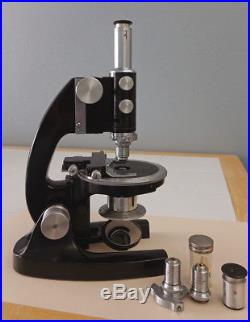
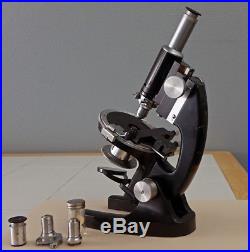
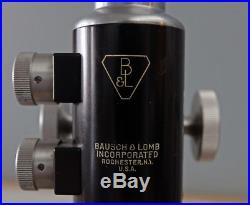
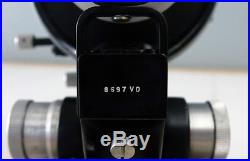
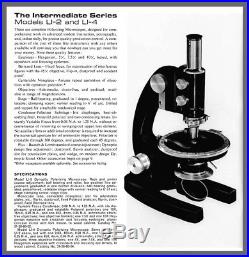
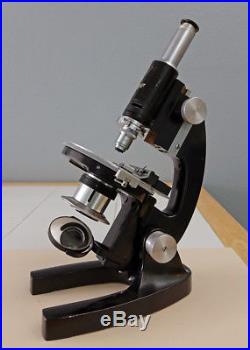
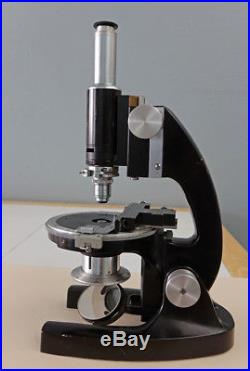
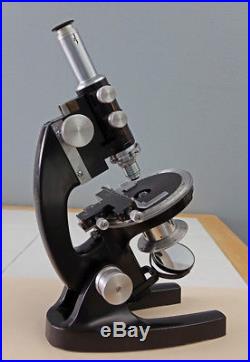
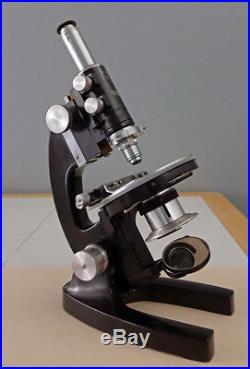
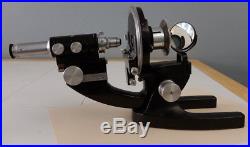
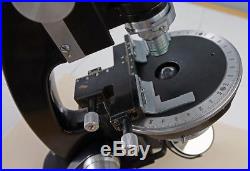
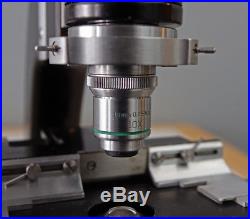
BAUSCH & LOMB VINTAGE LI-2 DYNOPTIC PETROGRAPHIC POLARIZING LAB MICROSCOPE, 1967. BAUSCH & LOMB VINTAGE MODEL LI-2 DYNOPTIC PETROGRAPHIC POLARIZING LABORATORY MICROSCOPE – 1967. Accompanying the instrument is a set of three (3) objective lenses and a pair of B&L crosshair eyepieces. This is a fully functional intermediate series research grade laboratory microscope that is still fully capable of both qualitative and quantitative petrographic analyses of minerals and crystals. The instrument also bears a serial number, which is found on the underside of the limb, 8697 VD (See image). This serial number dates this instrument to the year 1967. As is mentioned in the 2003 publication entitled, The Petrographic Microscope: Evolution of a Mineralogical Research Instrument by Daniel E. Kile, petrographic microscopes and accessories are comparatively rare. For every 100 biological microscopes manufactured, perhaps only one was made for petrographic use. In addition, petrographic microscopes are much more complicated than biological microscopes. Although the magnifying powers used are comparable and not so great, there are attached appliances for special examination of mineral or chemical substances that require very careful adjustment. This vintage Bausch & Lomb specialty microscope is equipped with such special features such as a rotating circular stage with peripheral vernier scale, an x-y mechanical stage, a flip-in/flip-out Bertrand Lens, a flip-in/flip-out Polaroid analyzer, a rotating substage condenser-Polaroid polarizer, a set of two (2) focusing cross hair eyepieces, a quick-change nosepiece with a pair of special adaptors for a compliment of three (3) strain-free objective lenses, and a port above the objective holder to accommodate special optional accessories (compensators / sliders) needed for the microscopic analysis of minerals. Accompanying this listing from my personal collection of antique and vintage microscope catalogues is a cut from the 1970 edition of B&Ls Catalogue of Polarizing Microscopes that shows this model microscope. It is included here for comparison with the featured instrument. The similarities to the featured instrument are readily apparent. Petrographic polarizing microscopes first made their appearance in Europe and the UK in the latter decades of the 19th Century. Such prominent microscope manufacturers as Nachet, Verick, Fuess, Lietz, Leiss, Zeiss, Reichert, Siebert, Watson, Swift & Son and others all produced their own versions of this specialty instrument. American microscope manufacturers soon followed suit. In the late 1890s Bausch & Lomb entered into a special cooperative business relationship with Zeiss in Germany, which allowed them to acquire some of the special technical expertise needed to produce a new line of petrographic polarizing microscopes in the USA. In addition, B&L used the design of Dr. Wright from the Carnegie Institution of Washington, D. To produce their own unique line of petrological polarizing microscopes. The end result was the introduction of the L series of Petrographic Polarizing Microscopes. This line initially included the LCH (Laboratory Model) and the LD (Research Model) with the familiar Jug-handle limb that was popular during the early decades of the 20th Century. By the early 1960s, the designs had become more refined and the line was renamed the Dynoptic Polarizing Microscope series, which involved the use of Polaroid analyzers and polarizers instead of crystal prisms. Relative to the word, Dynoptic, B&L stated in their literature: The word DYNOPTIC has been chosen to be indicative of the mechanical and optical excellence with which this series of microscopes has been endowed. Offered here is an early example of a Model LI-2 Dynoptic Petrographic Polarizing Microscope from the mid-20th Century. For the vintage / antique microscope collector this B&L Model LI-2 Dynoptic Petrographic Polarizing Microscope represents one of several significant advances in the evolution and design of this specialty microscope offered by the US based Bausch & Lomb Optical Company. As such, it will be a most welcome and valuable addition to any vintage / antique microscope collection, especially one with an emphasis on petrographic polarizing microscopes. As an added bonus, it still is 100% fully functional, and, it can still be used in a modern petrographic laboratory to conduct both qualitative and quantitative analyses of mineral samples. Dont miss this opportunity to make this sophisticated scientific instrument your own. This microscope is built upon B&Ls modern Dynoptic stand that consists of a heavy elongated horseshoe-shaped base with an integral short split pillar that rises from the base and terminates in a trunnion joint. This joint supports the rest of the microscope, including the widely sweeping -continental style arm, the stage, the body tube and the substage assembly. The trunnion joint allows the microscope to be tilted at any angle from the vertical to allow for the comfortable viewing of specimen slides atop the stage. Coarse focus is by angled rack and pinion. Fine adjustment is by a pair of micrometer knobs found on either side of the trunnion joint. The knob on the right side has a vernier scale with the inscribed notation that 1 division is equal to 0.001mm in the fine focus of the instrument a very precise level of fine focus on any microscope. The microscope is equipped with a centerable 130 mm diameter ball-bearing circular rotating stage with an engraved vernier scale on the periphery. The stage circumference is graduated in single degrees with each tenth line numbered. An arrest mechanism is provided at the left side of the stage to lock the stage in place, if desired. This particular instrument is equipped with an x-y mechanical stage with its own vernier scale. It includes an adjustable slide holder, which can accommodate a full range of slide sizes from the smallest to the larger types often used for prepared mineral thin sections. Below the stage is a relatively complex substage apparatus consisting of a condenser/ polarizer assembly with an integral iris diaphragm, heat-adsorbing filter, Polaroid polarizer and two condensing lenses. The condenser has a variable focus feature from 0.08 N. To 1.25 N. Without the inconvenience of removing or swinging-out the upper lens element. The polarizer is rotatable through 360 degrees and is graduated at each 45 degrees. Under the substage condenser / polarizer unit is a 54mm diameter plano-concave mirror on a removable double prong mirror support that completes the substage illumination system. The body tube of this microscope is much more complex than that found on a conventional biological microscope. At the top of the body tube is an ocular holder with a slot in its upper edge. This feature is designed for fixing the azimuth of cross hair eyepieces used on the instrument. Two (2) B&L Huygenian focusing cross hair keyed eyepieces are provided with the instrument: A 7.5x and a 10x. About a third of the way down the body tube below the eyepiece holder is a flip-in/flip-out fixed focus Bertrand lens that is used with the 45x objective for the examination of interference figures of mineral specimens. A hand knob on the right side of the instrument controls its position either into or out of the optical path. It is also sealed in place to prevent dust entry into the body tube. At the approximate lower third of the body tube is a flip-in/flip-out Polaroid analyzer. It too is controlled by a hand knob found on the right side of the body tube allowing it to be moved into or out of the optical path with a quick flip of the wrist. Below the analyzer is a port that is used to accommodate optional polarizing sliders/compensators. Note: In this case, no compensators are included with this instrument. Under the slider port is a special fitting with a locking mechanism for the objective lenses. Three (3) strain-free objective lenses (all by B&L) are provided with the instrument: A 10x 16mm 0.25 N. A 21x 8mm 0.50 NAand a 45x 4mm 0.85 N. Included with the objectives is a pair of special adaptors with centering pins, which are used to center the objectives. This microscope stands about 13.5 inches tall and weighs about 12 pounds a relatively heavy vintage microscope. There is no wood case or any other accessories included with this microscope. NOTE: The accompanying images are a part of this statement of condition. Please take the time to view all of the images so you can confirm the condition of the instrument and so you will know exactly what you will be getting should you prove to be the proud new owner of this vintage B&L Model LI-2 Dynoptic Petrographic Polarizing microscope. In summary, this microscope is in very good to excellent condition cosmetically, mechanically and optically. As the accompanying images attest, the black lacquered metal and chromed parts of this instrument are in very good to excellent condition. There are just a few very minor rub marks on the side and back of the limb, under the stage, and on the rear of the mechanical stage. The optics associated with this microscope are in excellent condition. Both the eyepieces and the objective lenses that come with the instrument are free of any optical defects. However, the 10x eyepiece is missing one of the cross hairs. The Bertrand lens and the Polariod analyzer are without any internal optical defects. The substage condenser with its iris diaphragm is in good condition. The substage polarizer is in good condition with no optical defects. The analyzer and polarizer act in concert to provide polarized light for the observation of minerals and crystals. The views under polarized light are quite pleasing, as the accompanying composite images of a thin section of the mineral Pyroxenite from the Canary Islands of Spain will testify. These images were captured using the 10x objective mounted on this very microscope. Images show the mineral under crossed polars. Note the resolution of some of the finer details of the mineral specimen evident in these images. The plano-concave mirror is in good condition with no major defects on either side. Mechanically, both the coarse and fine focus mechanisms work smoothly and flawlessly on this instrument. The stage rotates smoothly and the arrest mechanism for the stage works properly. The substage apparatus works perfectly and it provides excellent illumination to the stage. The left coarse focus knob has a very slight warp, but this does not in any way affect the proper adjustment of the coarse focus. The sliding cover for the compensator port is missing its lever and so the port currently remains in the open position. However, if desired, it can be closed easily using a forceps or blunt needle. Overall, this is a very nicely preserved example of a vintage Bausch & Lomb Model LI-2 Dynoptic Petrographic Polarizing Microscope from the mid-20th Century. It is certainly worthy of any vintage / antique microscope collection. And, should one choose to do so, it can still be used to this day for the serious qualitative examination and detailed quantitative analysis of mineral and other suitable specimens under polarized light. We will also entertain reasonable offers for this fully functional vintage precision instrument. FREE scheduling, supersized images and templates. Get Vendio Sales Manager. Make your listings stand out with FREE Vendio custom templates! Over 100,000,000 served. Get FREE counters from Vendio today! The item “BAUSCH & LOMB VINTAGE LI-2 DYNOPTIC PETROGRAPHIC POLARIZING LAB MICROSCOPE, 1967″ is in sale since Saturday, November 10, 2018. This item is in the category “Business & Industrial\Healthcare, Lab & Dental\Medical & Lab Equipment, Devices\Microscopes”. The seller is “mtloggera” and is located in Hamilton, Montana. This item can be shipped worldwide.
- Viewer: Monocular
- Microscope Structure: Upright
- Brand: Bausch and Lomb
- Microscope Type: Polarizing Microscope
- Country/Region of Manufacture: United States
- Intended Use/Discipline: Geological/minerological Laboratory
- Model: LI-2 Petrographic Polarizing Microscope
 If you like this post and would like to receive updates from this blog, please subscribe our feed.
If you like this post and would like to receive updates from this blog, please subscribe our feed.
